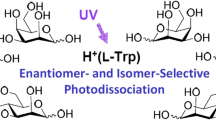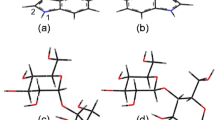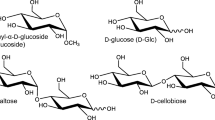Abstract
Photostability of cold gas-phase tryptophan (Trp) enantiomers in L-serine (L-Ser) clusters at 8 K as a model for interstellar molecular clouds was examined using a tandem mass spectrometer containing a cold ion trap to investigate the hypothesis that homochirality in gas-phase Ser clusters promotes the enantiomeric enrichment of other amino acids via enantiomer-selective photolysis with linearly polarized light. In the UV excitation of heterochiral H+ (L-Ser) 3(D-Trp), the CO2-eliminated product in the cluster was observed. In contrast, the photodissociation mass spectrum of homochiral H+(L-Ser)3(L-Trp) showed that photolysis of amino acids in the cluster did not occur due to the evaporation of L-Ser molecules. In the spectra of the homochiral H+(L-Ser) (L-Trp) and heterochiral H+(L-Ser) (D-Trp), the evaporation of L-Ser was the primary reaction pathway, and no difference between the L- and D-enantiomers was observed. The findings confirm that when 3 L-Ser units are present in the cluster, the photolytic decomposition of Trp is enantiomerically selective.
Similar content being viewed by others
Introduction
The origin of life is one of the most interesting subjects in science, and a number of hypotheses for the origin of homochirality in biomolecules have been proposed based on several experimental and analytical studies (Bonner 1991; Ruiz-Mirazo et al. 2014). One such hypothesis is the extraterrestrial origin of biomolecules, which proposes that biological molecules were formed in the interstellar space and delivered to the Earth. This proposal was examined by studying the abiotic formation of amino acids under simulated extraterrestrial conditions and by searching for the enantiomeric enrichment of amino acids in meteorites.
Chemical processes in interstellar molecular clouds occur at low temperatures (10–100 K), at low densities (102–104 cm−3), and in intense radiation fields. Previous work has shown that ultraviolet (UV) irradiation of interstellar molecules such as H2O, CH3OH, NH3, and HCN, condensed on a cold solid surface, formed several amino acids such as serine and alanine as racemates (Bernstein et al. 2002; Caro et al. 2002). These results suggest the possibility of the abiotic formation of amino acids under extraterrestrial conditions. However, no enantiomeric selectivity was observed.
L-Enantiomer-enriched amino acids found in the Murchison meteorites indicated an extraterrestrial origin of homochirality (Cronin and Pizzarello 1997). The observation of the circular polarization of light in star-formation regions suggested that enantiomer-selective photodestruction could induce the enantiomeric enrichment of amino acids in the interstellar space (Bailey et al. 1998; Meinert et al. 2011). On the basis of these results, a hypothesis for the extraterrestrial origin of homochirality in biomolecules was formulated, suggesting a process whereby the abiotic formation of racemic amino acids occurs in the interstellar molecular clouds, and is followed by the enantiomer-selective photodestruction of the D-enantiomer with circularly polarized light.
Laboratory studies on amino acids in the interstellar molecular cloud analogues have been limited to the condensed phase because of the difficulty in generating temperature-controlled hydrogen-bonded clusters containing biological molecules in the gas phase. To understand chemical processes in the interstellar molecular clouds, it is necessary to study the structure and reactivity of mass-selected and temperature-controlled gas-phase clusters consisting of interstellar and biological molecules. We proposed a hypothesis for the origin of enantiomeric enrichment based upon enantiomer-enriched amino acids found in meteorites (Cronin and Pizzarello 1997) and enantiomer selectivity of organic chiral molecules on surface (Soai et al. 1999; Hazen et al. 2001; Orme et al. 2001); according to this hypothesis, enantiomer-selective photolysis of amino acids on chiral substances with linearly polarized light could induce enantiomeric enrichment of L-amino acids. In a previous work, we examined UV photolysis of gas-phase amino acid–chiral molecular complexes at low temperatures with linearly polarized light using a tandem mass spectrometer containing a temperature-variable ion trap, and detected enantiomer-selective photolysis of cold gas-phase protonated tryptophan (TrpH+) with a chiral crown ether (Fujihara et al. 2014). These results show that enantiomer-selective photolysis of amino acids on chiral substances with linearly polarized light was important in understanding the origin of the enantiomeric enrichment of amino acids.
In this study, we examined the UV photolysis of cold gas-phase tryptophan (Trp) enantiomers in L-serine clusters as interstellar molecular cloud analogues. Serine (Ser) forms magic-number cluster ions composed of eight amino acid units in the gas phase, and the clusters show a remarkable preference for homochirality (Cooks et al. 2001; Nanita and Cooks 2006). On the basis of the results, we discussed the possibility that the stability and preference for homochirality of gas-phase Ser clusters induces the enantiomeric enrichment of other amino acids via enantiomer-selective photolysis with linearly polarized light.
Methods
L-Ser, L-Trp, and D-Trp were obtained from Sigma–Aldrich. A solution containing 0.5 mM of Trp and 2 mM of L-Ser in a mixture of water and methanol (50/50) with 1 % acetic acid was used.
Details of the experimental apparatus have been described previously (Fujihara et al. 2014). Hydrogen-bonded cluster ions were generated by electrospray ionization and transferred to the gas phase through a capillary and skimmer. The ions were guided by an octopole, and mass-selected by a quadrupole mass filter. The mass-selected ions were decelerated and refocused by a stack of cylindrical electrodes into a temperature-variable 22-pole ion trap (8–350 K). In the trap, the ions were thermalized by multiple collisions with the He buffer gas contained within a copper housing at a well-defined temperature, analogous to a thermal bath (Gerlich 1995). The temperature-controlled ions were extracted from the trap and then irradiated with a photo dissociation laser pulse. The fragment ions were orthogonally accelerated to 2.8 keV by two-stage pulsed electric fields, and then mass-analyzed by a reflectron time-of-flight (TOF) mass spectrometer. The repetition rate of the experimental cycle was 10 Hz, and the trapping time of the ions was ~80 ms. The fourth harmonic of a Nd: YAG laser (Minilite II, Continuum) was used as the photodissociation light. The typical laser fluence was around 2 mJ/cm2.
Results and Discussion
Mass Spectra
Figure 1 shows a typical TOF mass spectrum of protonated water clusters H+(H2O) n generated by electrospray ionization and with the temperature controlled to 8 K. Electrospray ionization involves a direct transfer of charged droplets from solutions to the gas phase. Our apparatus could generate mass-selected and temperature-controlled hydrogen-bonded cluster ions in the gas phase. The mass spectrum exhibits intensity enhancements at n =21 and 28. The ion intensity distribution for H+(H2O) n agreed with the observations reported by several groups, in which H+(H2O) n was generated in the gas phase using supersonic expansion (Nagashima et al. 1986). The closed cage structures of H+(H2O)21 and H+(H2O)28 were reported using infrared (IR) photo dissociation spectroscopy (Miyazaki et al. 2004, Wu et al. 2005).
Figure 2 shows typical TOF mass spectra of homochiral H+(L-Ser) n (L-Trp) m and heterochiral H+(L-Ser) n (D-Trp) m clusters at 8 K. The (n, m) values for major cluster ions are indicated in the spectrum. H+(L-Ser)4 and H+(L-Ser)8 were stable magic-number clusters, as reported previously (Nanita and Cooks 2006). In addition to protonated serine clusters, substitutions of L-Ser with L-Trp in clusters, producing H+(L-Ser) n (L-Trp) and H+(L-Ser) n (L-Trp)2, were observed. Protonated clusters with (n + m) even numbers of amino acids were mainly generated, indicating that the clusters consisted of amino acid dimer subunits (Cooks et al. 2001). A noticeable difference between the homochiral and heterochiral clusters was not detected in the mass spectra shown in Fig. 2a and b.
Evaporation of Molecules
To examine the photochemical and photophysical properties of cold gas-phase TrpH+ enantiomers in L-amino acid clusters, UV photodissociation experiments were performed. The irradiation wavelength was 266 nm, which excites the indole ring of tryptophan to the ππ* excited state (Grégoire et al. 2009).
Figure 3 shows the photodissociation mass spectra of homochiral H+(L-Ser) (L-Trp) and heterochiral H+(L-Ser) (D-Trp) (m/z 310) at 8 K, which are n = m =1 clusters. In the homochiral H+(L-Ser) (L-Trp) shown in Fig. 3a, evaporation of L-Ser, forming H+(L-Trp) (m/z 205), was the primary photodissociation pathway. The proton in H+(L-Ser) (L-Trp) remained associated with L-Trp after the photo-induced evaporation. This is because the proton affinity of Trp is larger by 26.4 kJ/mol compared to that of Ser (Bojesen and Breindahl 1994). Fragment ions resulting from NH3 loss, (NH3 + CH2CO) loss, (NH3 + CO2) loss, NHCHCOOH loss, and NH2CH2COOH loss from free H+(L-Trp), corresponding to m/z 188, 146, 144, 132, and 130, respectively, are observed in the spectrum. The peak marked with an asterisk is assigned to the NH3-eliminated product from free L-TrpH+ in the field-free region of the reflectron TOF mass spectrometer. These fragment ions were also formed in photo-induced dissociation (PID) and low-energy collision-induced dissociation (CID) experiments of free TrpH+ (Grégoire et al. 2009, Aribi et al. 2004). The observations indicate that the fragment ions observed in the spectrum of H+(L-Ser) (L-Trp) were formed by a sequential reaction via the evaporation of an L-Ser molecule. The photodissociation mass spectrum of heterochiral H+(L-Ser) (D-Trp), shown in Fig. 3b, is similar to that of homochiral H+(L-Ser) (L-Trp) shown in Fig. 3a. Therefore, no enantioselectivity of the photolysis process was observed in the 1:1 clusters.
Figure 4 shows the photodissociation mass spectra of homochiral H+(L-Ser)3(L-Trp) and heterochiral H+(L-Ser)3(D-Trp) (m/z 520) at 8 K. In the spectrum of homochiral H+(L-Ser)3(L-Trp) shown in Fig. 4a, evaporation of (L-Ser)2 forming H+(L-Ser) (L-Trp) was the main photodissociation pathway, and H+(L-Trp) and NH3-eliminated product from free L-TrpH+ (m/z 188) were observed. The m/z 188 product is considered to be formed by a sequential reaction via the evaporation of L-Ser molecules. The results that H+(L-Ser) (L-Trp) formed via evaporation of (L-Ser)2 was the main product and H+(L-Ser)2(L-Trp) was the minor peak indicated that H+(L-Ser)3(L-Trp) consisted of amino acid dimer subunits (Cooks et al. 2001), which was consistent with the observations of the mass spectrum shown in Fig. 2a. Evaporation of L-Ser molecules was the main process in UV excitation of homochiral H+(L-Ser)3(L-Trp). Photolysis of amino acid molecules in the clusters was not observed in H+(L-Ser)3(L-Trp), H+(L-Ser) (L-Trp), and H+(L-Ser) (D-Trp). This is because the energy absorbed in the Trp molecule was released through the evaporation of L-Ser molecules.
Photolysis in Cluster
In the photodissociation mass spectrum of heterochiral H+(L-Ser)3(D-Trp) shown in Fig. 4b, H +(L-Ser) (D-Trp) and H+(D-Trp) formed via evaporation of L-Ser molecules, and the NH3-eliminated product from free D-TrpH+ was observed, as in the case of homochiral H+(L-Ser)3(L-Trp) shown in Fig. 4 a. The clusters also consisted of amino acid dimer subunits. In addition to these product ions, the CO2-eliminated product from H+(L-Ser) (D-Trp) (m/z 266) was observed, which corresponded to the photolysis product of D-Trp molecule in the L-Ser cluster. In contrast, fragmentations induced by proton transfer, such as NH3 loss, (NH3 + CH2CO) loss, (NH3 + CO2) loss, NHCHCOOH loss, and NH2CH2COOH loss from H+(L-Trp), which were the main fragmentation pathway of free TrpH+ (Grégoire et al. 2009, Aribi et al. 2004), were not observed in the cluster.
In the case of UV photolysis of cold gas-phase TrpH+ enantiomers with crown ethers, CO2 loss was observed, whereas the fragmentations induced by proton transfer from the NH3 + group of TrpH+ were suppressed due to the hydrogen bonding of the NH3 + group with the crown ether (Fujihara et al. 2014). The CO2 loss from amino acids was previously reported to be the dominant photoproduct under UV irradiation using standard matrix isolation techniques, in which the amino acids were non-zwitterionic, having both NH2 and COOH groups (Ehrenfreund et al. 2001). Therefore, the proton in H+(L-Ser)3(D-Trp) was assumed to localize in the cluster, and CO2 loss was the main photolysis process in the heterochiral cluster under UV irradiation. Photolysis in clusters was not observed in the spectra of H+(L-Ser)3(L-Trp), H+(L-Ser) (L-Trp), and H+(L-Ser) (D-Trp) shown in Fig. 3a and b, Fig. 4a, respectively, due to the evaporation of L-Ser molecules. The CO2 loss in cluster observed only in the spectrum of heterochiral H+(L-Ser)3(D-Trp) shown in Fig. 4b confirms the enantiomer-selective photolysis of D-Trp in the L-Ser cluster. However, a Ser: Trp ratio of at least 3:1 is needed for this phenomenon to occur. In the chiral specific reaction, multiple-point interactions in a polydentate complex are required, even if only transiently. The UV excitation of heterochiral H+(L-Ser)3(D-Trp) induces the evaporation of (L-Ser)2 and CO2 loss, forming the chiral-specific CO2-eliminated product from H+(L-Ser) (D-Trp).
These results indicate that homochirality in gas-phase Ser clusters could promote the enantiomeric enrichment of other amino acids, and suggest that enantiomer-selective photolysis with linearly polarized light in gas-phase clusters plays an important role in the enantiomeric enrichment step. It is necessary to study the structure and reactivity of gas-phase clusters consisting of interstellar and biological molecules as a function of cluster size and temperature in understanding chemical processes in interstellar molecular clouds.
References
Aribi HE, Orlova G, Hopkinson AC, Siu KWM (2004) Gas-phase fragmentation reactions of protonated aromatic amino acids: concomitant and consecutive neutral eliminations and radical cation formations. J Phys Chem A 108:3844–3854
Bailey J, Chrysostomou A, Hough JH, Gledhill TM, McCall A, Clark S, Ménard F, Tamura M (1998) Circular polarization in star-formation regions: implications for biomolecular homochirality. Science 281:672–674
Bernstein MP, Dworkin JP, Sandford SA, Cooper GW, Allamandola LJ (2002) Racemic amino acids from the ultraviolet photolysis of interstellar ice analogues. Nature 416:401–403
Bojesen G, Breindahl T (1994) On the proton affinity of some α-amino acids and the theory of the kinetic method. J Chem Soc Perkin Trans 2:1029–1037
Bonner WA (1991) The origin and amplification of biomolecular chirality. Orig Life Evol Biosph 21:59–111
Caro GMM, Meierhenrich UJ, Schutte WA, Barbier B, Segovia AA, Rosenbauer H, Thiemann WHP, Brack A, Greenberg JM (2002) Amino acids from ultraviolet irradiation of interstellar ice analogues. Nature 416:403–406
Cooks RG, Zhang D, Koch KJ, Gozzo FC, Eberlin MN (2001) Chiroselective self-directed octamerization of serine: implications for homochirogenesis. Anal Chem 72:3646–3655
Cronin JR, Pizzarello S (1997) Enantiomeric excesses in meteoritic amino acids. Science 275:951–955
Ehrenfreund P, Bernstein MP, Dworkin JP, Sandford SA, Allamandola LJ (2001) The photostability of amino acids in space. Astrophys J 550:L95–L99
Fujihara A, Sato T, Hayakawa S (2014) Enantiomer-selective ultraviolet photolysis of temperature-controlled protonated tryptophan on a chiral crown ether in the gas phase. Chem Phys Lett 610–611:228–233
Gerlich D (1995) Ion-neutral collisions in a 22-pole trap at very low energies. Phys Scr T59:256–263
Grégoire G, Lucas B, Barat M, Fayeton JA, Dedonder-Lardeux C, Jouvet C (2009) UV photoinduced dynamics in protonated aromatic amino acid. Eur Phys J D Atom Mol Opt Phys 51:109–116
Hazen RM, Filley TR, Goodfriend GA (2001) Selective adsorption of L- and D-amino acids on calcite: implications for biochemical homochirality. Proc Natl Acad Sci 98:5487–5499
Meinert C, d’ Marcellus P, Hendecourt LLS, Nahon L, Jones NC, Hoffmann SV, Bredehöft JH, Meierhenrich UJ (2011) Photochirogenesis: photochemical models on the absolute asymmetric formation of amino acids in interstellar space. Phys Life Rev 8:307–330
Miyazaki M, Fujii A, Ebata T, Mikami N (2004) Infrared spectroscopic evidence for protonated water clusters forming nanoscale cages. Science 304:1134–1137
Nagashima U, Shinohara H, Nishi N, Tanaka H (1986) Enhanced stability of ion-clathrate structures for magic number water clusters. 84: 209–214
Nanita SC, Cooks RG (2006) Serine octamers: cluster formation, reactions, and implications for biomolecule homochirality. Angew Chem Int Ed 45:554–569
Orme CA, Noy A, Wierzbicki A, McBride MT, Grantham M, Teng HH, Dove PM, DeYoreo JJ (2001) Formation of chiral morphologies through selective binding of amino acids to calcite surface steps. Nature 411:775–779
Ruiz-Mirazo K, Briones C, Escosura A (2014) Prebiotic systems chemistry: new perspectives for the origins of life. Chem Rev 114:285–366
Soai K, Osanai S, Kadowaki K, Yonekubo S, Shibata T, Sato I (1999) d- and l-quartz promoted highly enantioselective synthesis of a chiral organic compound. J Am Chem Soc 121:11235–11236
Wu CC, Lin CK, Chang HC, Jiang JC, Kuo JL, Klein ML (2005) Protonated clathrate cages enclosing neutral water molecules: H+(H2O)21 and H+(H2O)28. J Chem Phys 122:074315
Acknowledgments
This work was supported by JSPS KAKENHI Grant Number 23750021, Grant from The Iwatani Naoji Foundation, and Grant from The Kurata Memorial Hitachi Science and Technology Foundation.
Author information
Authors and Affiliations
Corresponding author
Rights and permissions
About this article
Cite this article
Fujihara, A., Maeda, N. & Hayakawa, S. Enantiomer-Selective Photolysis of Cold Gas-Phase Tryptophan in L-Serine Clusters with Linearly Polarized Light. Orig Life Evol Biosph 44, 67–73 (2014). https://doi.org/10.1007/s11084-014-9370-9
Received:
Accepted:
Published:
Issue Date:
DOI: https://doi.org/10.1007/s11084-014-9370-9








